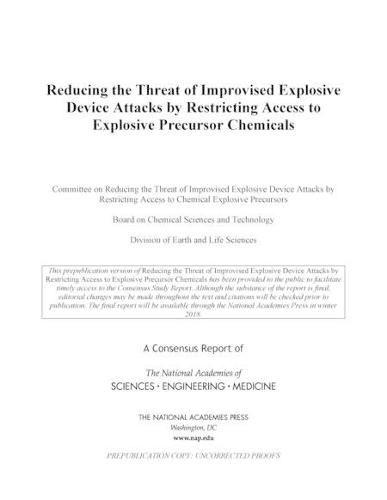Reducing the Threat of Improvised Explosive Device Attacks by Restricting Access to Explosive Precursor Chemicals
National Academies of Sciences, Engineering, and Medicine,Division on Earth and Life Studies,Board on Chemical Sciences and Technology,Committee on Reducing the Threat of Improvised Explosive Device Attacks by Restricting Access to Chemical Explosive Precursors

Reducing the Threat of Improvised Explosive Device Attacks by Restricting Access to Explosive Precursor Chemicals
National Academies of Sciences, Engineering, and Medicine,Division on Earth and Life Studies,Board on Chemical Sciences and Technology,Committee on Reducing the Threat of Improvised Explosive Device Attacks by Restricting Access to Chemical Explosive Precursors
Improvised explosive devices (IEDs) are a type of unconventional explosive weapon that can be deployed in a variety of ways, and can cause loss of life, injury, and property damage in both military and civilian environments. Terrorists, violent extremists, and criminals often choose IEDs because the ingredients, components, and instructions required to make IEDs are highly accessible. In many cases, precursor chemicals enable this criminal use of IEDs because they are used in the manufacture of homemade explosives (HMEs), which are often used as a component of IEDs.
Many precursor chemicals are frequently used in industrial manufacturing and may be available as commercial products for personal use. Guides for making HMEs and instructions for constructing IEDs are widely available and can be easily found on the internet. Other countries restrict access to precursor chemicals in an effort to reduce the opportunity for HMEs to be used in IEDs. Although IED attacks have been less frequent in the United States than in other countries, IEDs remain a persistent domestic threat. Restricting access to precursor chemicals might contribute to reducing the threat of IED attacks and in turn prevent potentially devastating bombings, save lives, and reduce financial impacts.
Reducing the Threat of Improvised Explosive Device Attacks by Restricting Access to Explosive Precursor Chemicals prioritizes precursor chemicals that can be used to make HMEs and analyzes the movement of those chemicals through United States commercial supply chains and identifies potential vulnerabilities. This report examines current United States and international regulation of the chemicals, and compares the economic, security, and other tradeoffs among potential control strategies.
This item is not currently in-stock. It can be ordered online and is expected to ship in approx 4 weeks
Our stock data is updated periodically, and availability may change throughout the day for in-demand items. Please call the relevant shop for the most current stock information. Prices are subject to change without notice.
Sign in or become a Readings Member to add this title to a wishlist.


